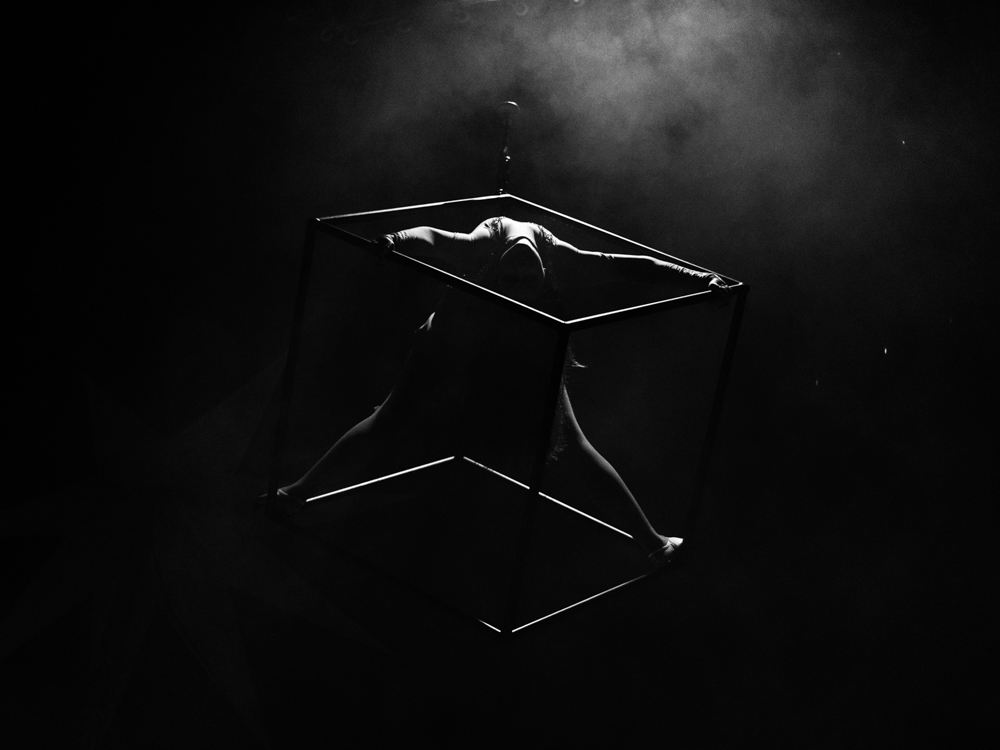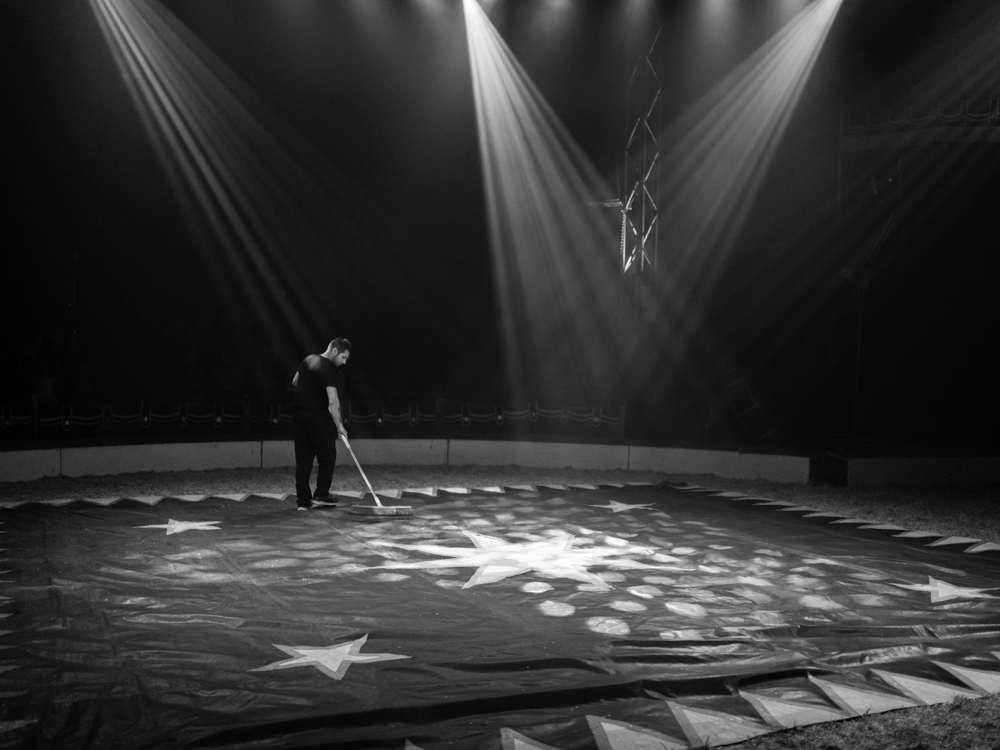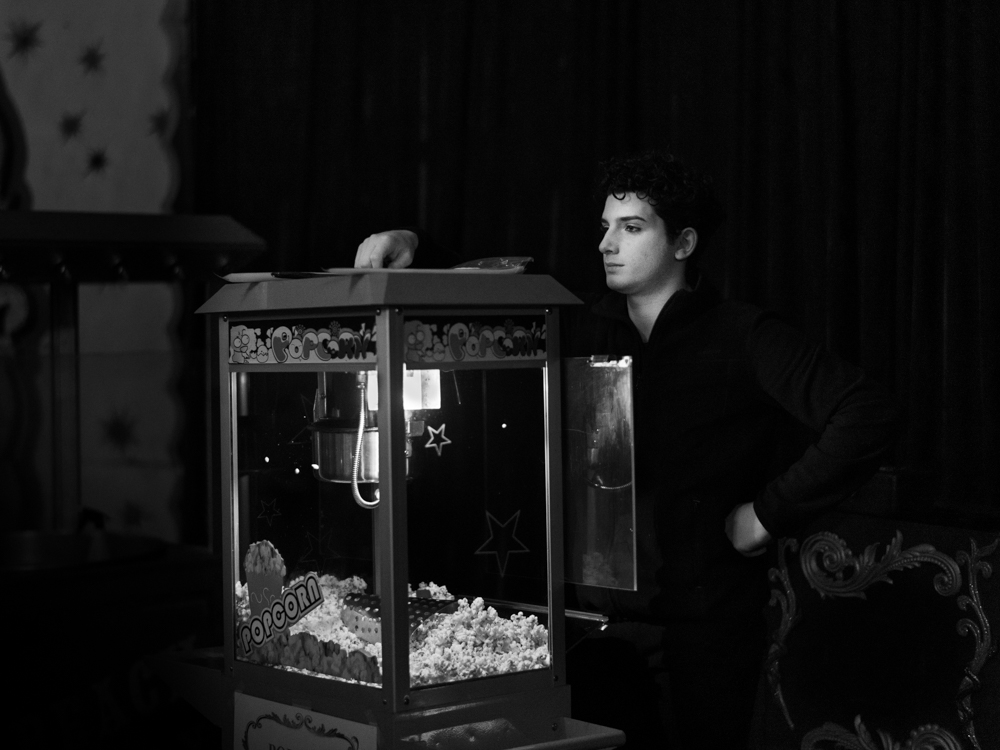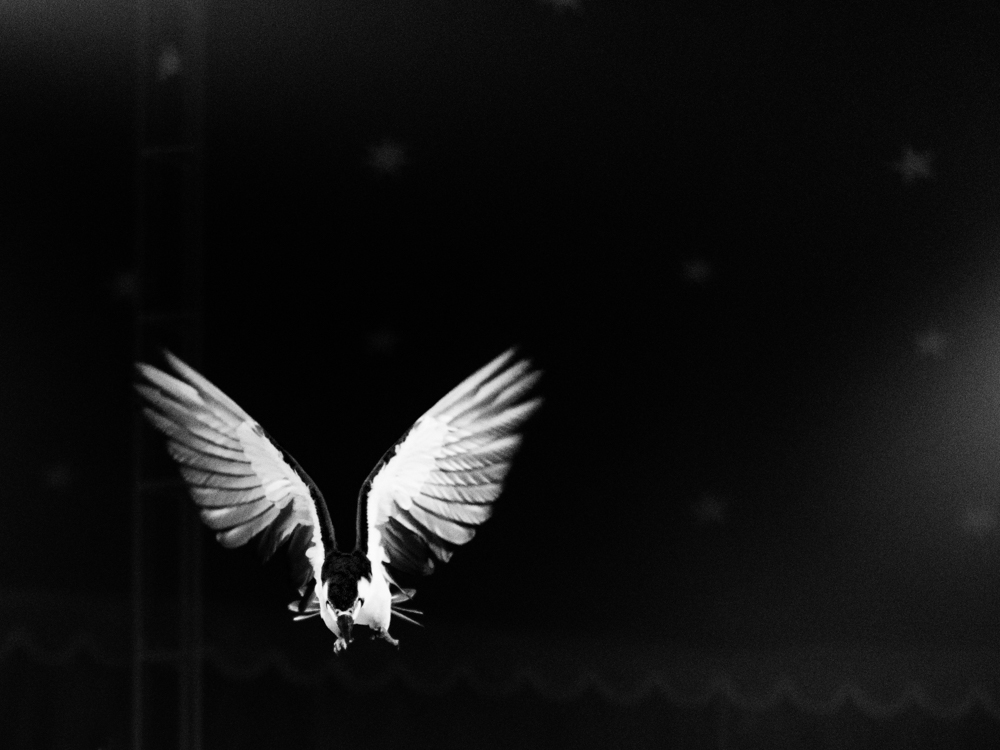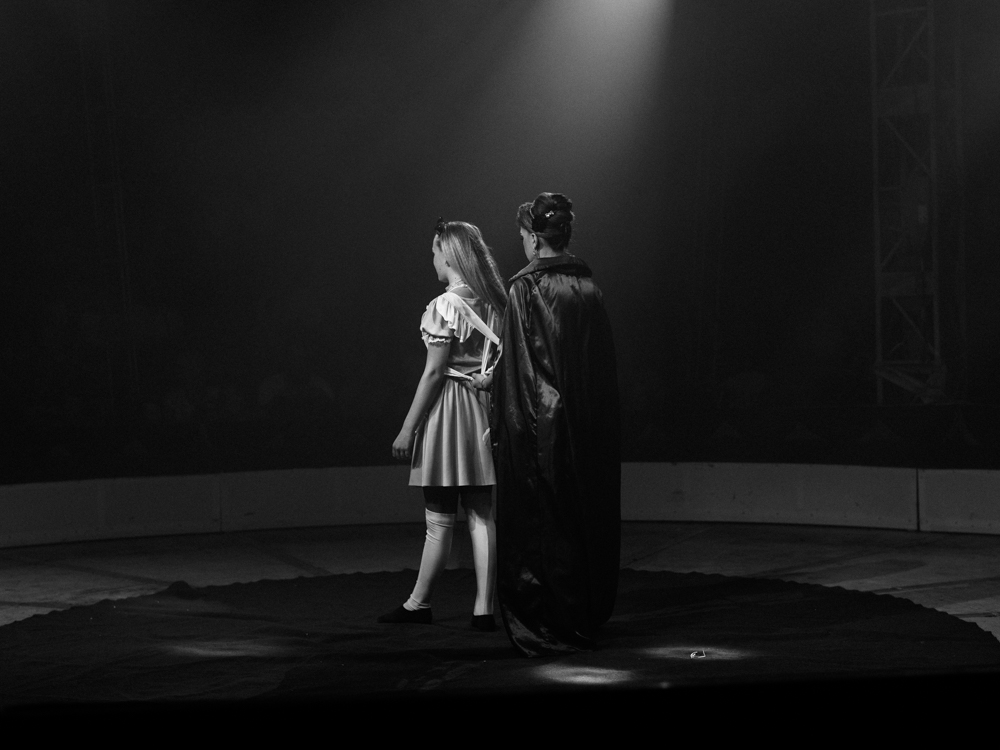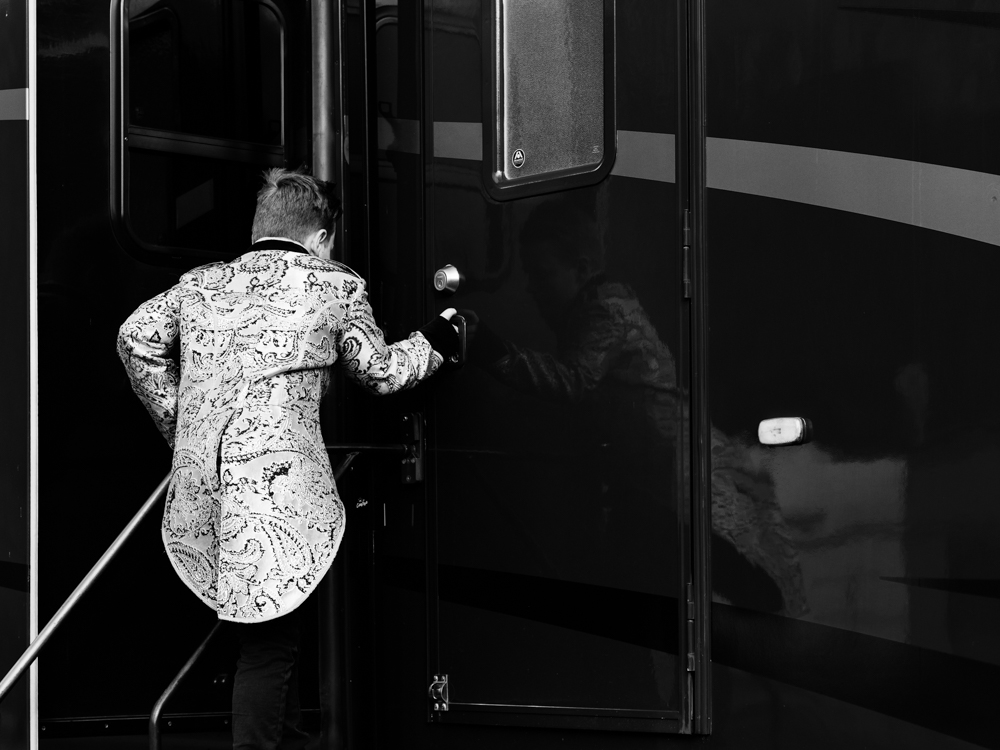European Street Photography Week: Sigrid Debusschere: Hidden Magic
It may be a one ring circus but do step in to meet the ring mistress of light, Sigrid Debusschere, a Belgian photographer of the streets, who has an uncanny ability to capture something much deeper than the typical circus in her images. Her series, “Hidden Magic” goes behind the scenes depicting Belgian circus life from unusual perspectives. Instead of colorful clowns, acrobats, and wild animals, we are led into a much more somber black and white world that exudes mystery and contemplation. I marveled at my reaction to that tuft of cotton candy in one of her images that almost looked like a weapon in the hands of the woman with a somewhat severe expression. The sign behind her reminded that it was nothing more than spun sugar, but my imagination was totally engaged.
Debusschere’s world of the circus is a look behind the curtain when the calliope has been silenced. The animals are strangely quiet and almost reflective in their poses. The performers are typically solitary souls in these images and the young, costumed boy running across the geometry of the tent behind him is the one indication that there may be a performance to come. But the true performer in these images is Debusschere whose depictions of light and shadow are both ethereal and mesmerizing.
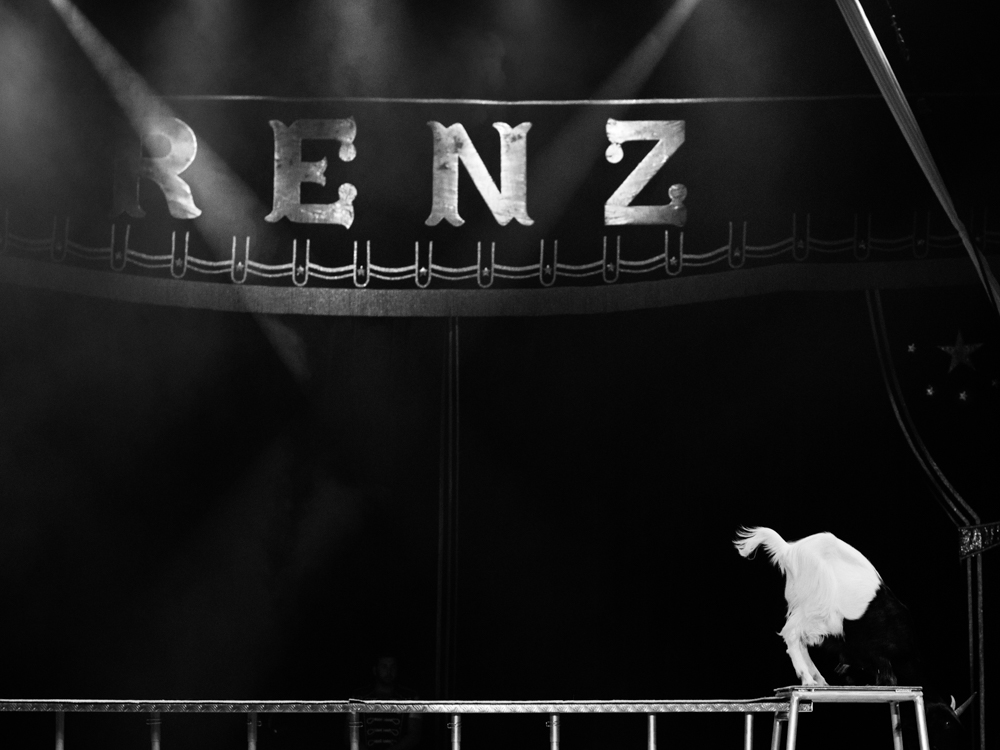
©Sigrid Debusschere, The goat, In Belgium wild animals have been banned in the circus since 2015, only domesticated species are permitted.
According to Debusschere, “Living in a circus means traveling and entertaining, in costumes and glittery suits, with hoops and trapezes, in a community where animals belong to the family. But what happens behind the scenes, or after the applause, usually stays out of sight. I want to show circus artists in their dignity. I traveled the country photographing various circus families.
To broaden the view of these communities, I capture what is not part of the spectacle, the moments when the entertainers are no longer watched. My images reveal their strong sense of tradition, show their daily life, as well as the stories between the acts.
Light and shadow are dramaturgical elements of the circus that I make grateful use of as a photographer. Just as the arena defines the place in which circus acts take shape, I use framing to set the scene. In this way I place the characters in relation to their surroundings and each other. Each photo tells its own story, together they read as a book, where the space between two pictures can be filled in by the viewer. Characters become persons, real people.”
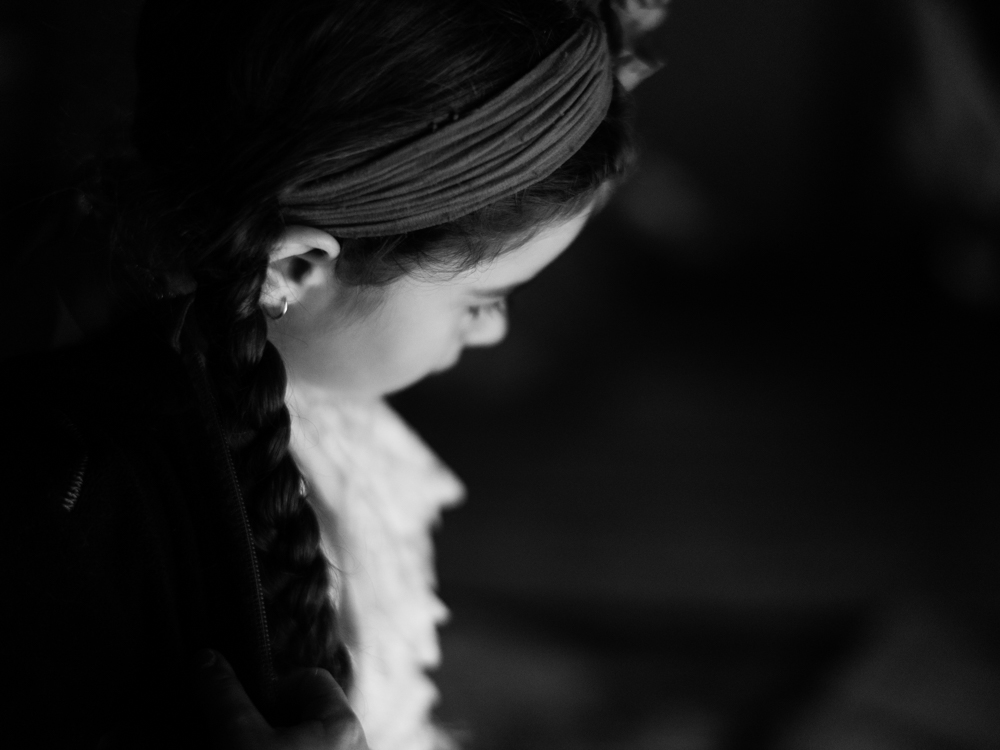
©Sigrid Debusschere, Circus girl waiting, A circus travels with the whole family together, each member has a role during the show.
Sigrid Debusschere was born in Ghent and lives near Brussels, Belgium. She is an award-winning photographer, including First Prize at the Maastricht Photo Festival (NL). Her work has been exhibited around the world, from NYC to Sydney, and has been published in several international magazines and photobooks. Her solo exhibition of ‘Hidden Magic’, is touring currently in 17 different locations in Belgium.
Sigrid enjoys the freedom of wandering in the streets but also likes to document daily life. She designed two books, ‘I am Awake’ and ‘Hidden Magic’. She is currently working on her third book and organizes workshops on ‘How to create your own handmade photobook’.
Follow Sigrid Debusschere on Instagram: @sigrid_debusschere
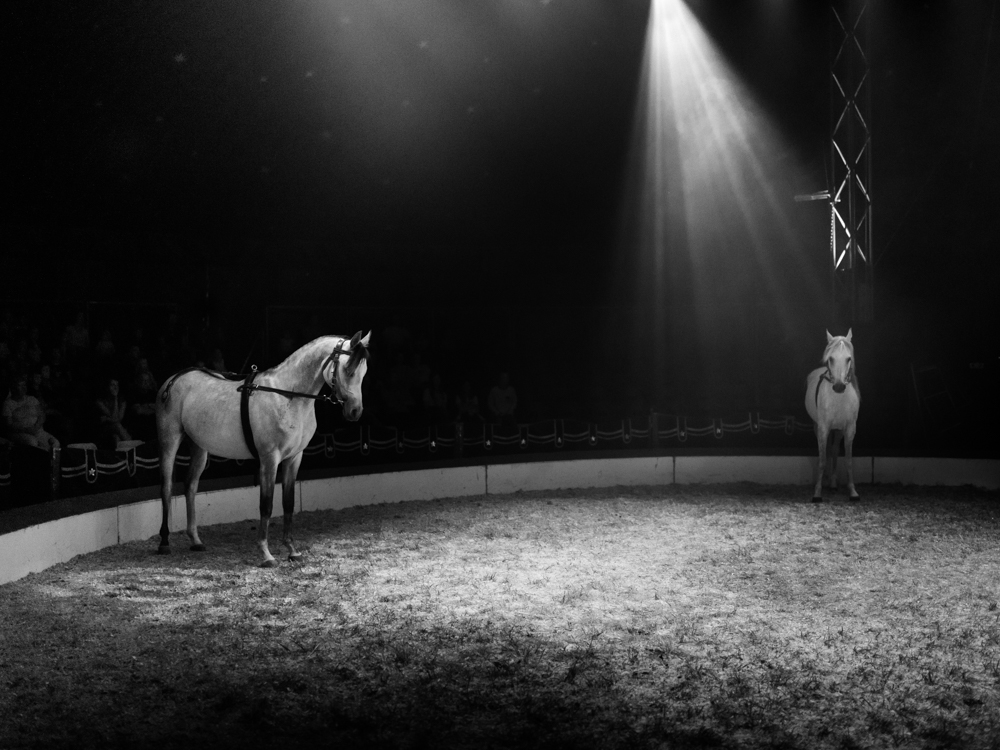
©Sigrid Debusschere, The two white horses, Every circus carries a number of animals on its journey. They are part of the family.
Michael Honegger: What drew you to the circus as a subject for your photography?
Sigrid Debusschere: Circuses have a historical and cultural significance that make them intriguing subjects for documentation. They have evolved over time and have played various roles in entertainment, storytelling, and community gatherings. I was interested in capturing both the spectacle of the performances and the behind-the-scenes moments that reveal the dedication and hard work of the performers and staff.
Circuses are filled with colorful costumes, various set designs, and unique performers, making them a rich source of visual inspiration. The combination of acrobatics, clowning, animal acts, and other performances offers a diverse range of subjects to capture.
The circus often brings together people from different backgrounds and talents, offering a unique opportunity to capture the essence of human connection and resilience.
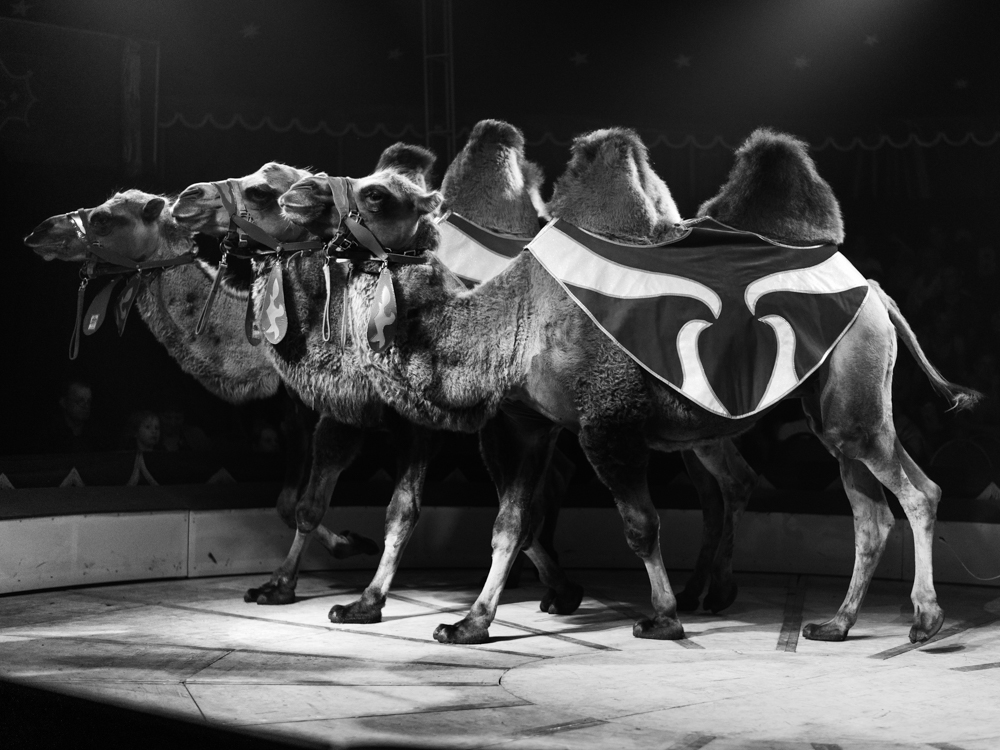
©Sigrid Debusschere, The three camels, The arena in these travelling circuses is tiny, it is impressive to see large animals performing in such a small circle.
MH: Your images of circus life are somewhat contradictory as we normally think of a circus as lively and jovial yet your images are more deeply personal and emit a sense of loneliness and introspection. Was this your intention?
SD: The longer I worked on this project the more I noticed the differences between the on-stage performances and the backstage atmosphere. So, I tried to explore the human experiences that are often hidden behind the spectacle and colorful façade.
By focusing on the quieter moments, the expressions of exhaustion, contemplation, and solitude, I aimed to tell a deeper and more complex story about the lives of the performers and the challenges they face. Through my lens, I shed light on the emotional toll, the sacrifices, and the vulnerabilities that coexist in the circus.
I seek to capture various aspects of the circus life, including emotions and atmospheres that are not immediately apparent on the surface, and I like to explore the human experiences that exist beyond the performances.
These hidden moments of contemplation are fascinating subjects and are telling a more nuanced story about circus life.
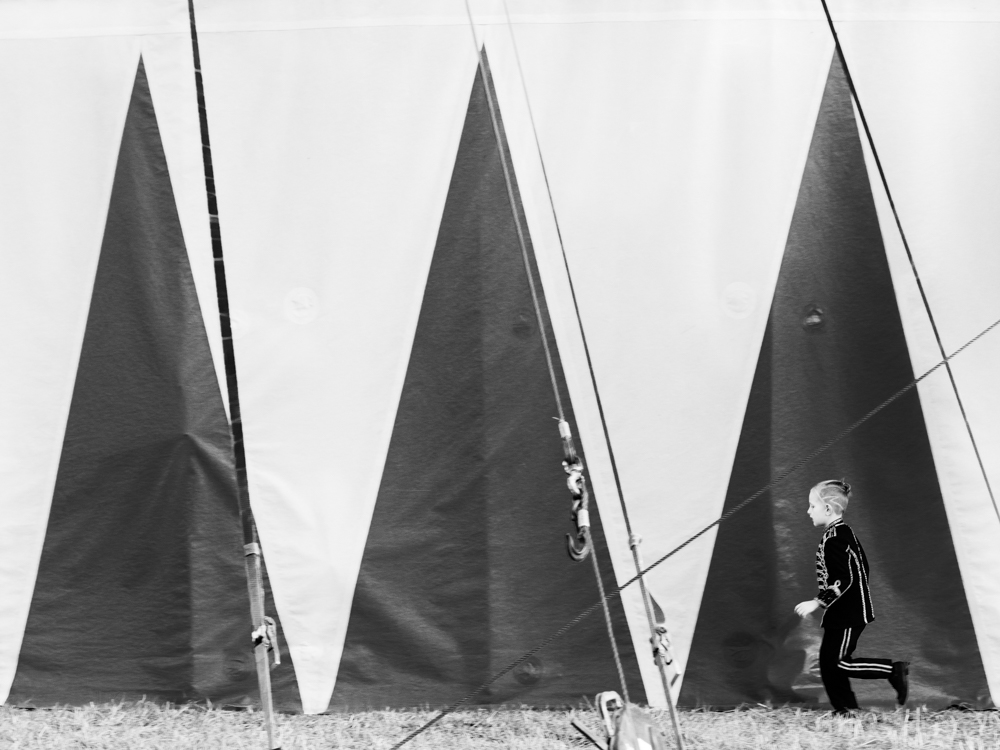
©Sigrid Debusschere, Circus boy running, The boy is running outside the tent to perform in the next act.
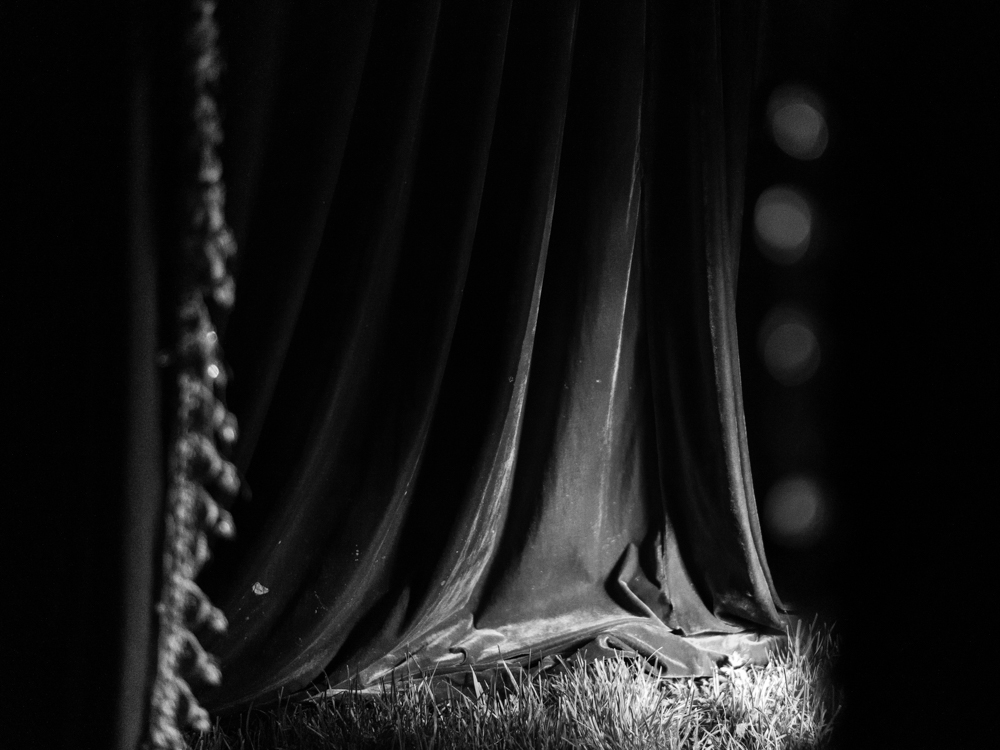
©Sigrid Debusschere, The curtain, The circus tents are rebuilt each time on grass fields or available spaces in cities.
MH: Can you share any interesting or memorable experiences you had while traveling and photographing various circus families?
SD: Each circus family warmly welcomed me into their community, which allowed me to capture more authentic and candid moments. I got the chance to go behind the scenes and document the preparation that goes into each performance, from applying makeup, stretching, rehearsing, to preparing their costumes.
I had the opportunity to spend time with these performers outside of their acts, capturing their everyday lives and showcasing their multifaceted nature.
Amidst the excitement of performances and travels, capturing moments of quiet reflection among circus members reveal a more introspective side to the performers’ lives.
Circus families live a nomadic lifestyle, which is both challenging and liberating.
MH: You use light and shadow as dramaturgical elements in your photographs. One normally thinks of a circus in colorful terms. What made you opt for dramatic black and white images for this project instead of color?
SD: The choice to use black and white was a deliberate artistic decision. It allows me to bring my unique perspective and vision to the project, shaping the way viewers perceive and interpret the circus scenes.
The absence of color emphasizes the shapes, forms, and textures of the subjects, which is particularly effective in capturing the details of circus costumes, props, and the human body in motion.
It also allows me to focus on the interplay between light and shadow, enhancing the dramatic aspects of the circus performances. By manipulating the contrast and tonal range, I can create images that emphasize the dynamic nature of the circus.
Without the distraction of color, viewers are encouraged to focus more on the composition, shapes, and lines within the frame. This leads to cleaner and more impactful compositions that draw attention to the key elements of the circus scenes.

©Sigrid Debusschere, The black and white pony, The pony stands alone in the circle, with no dresseur, no visible audience.
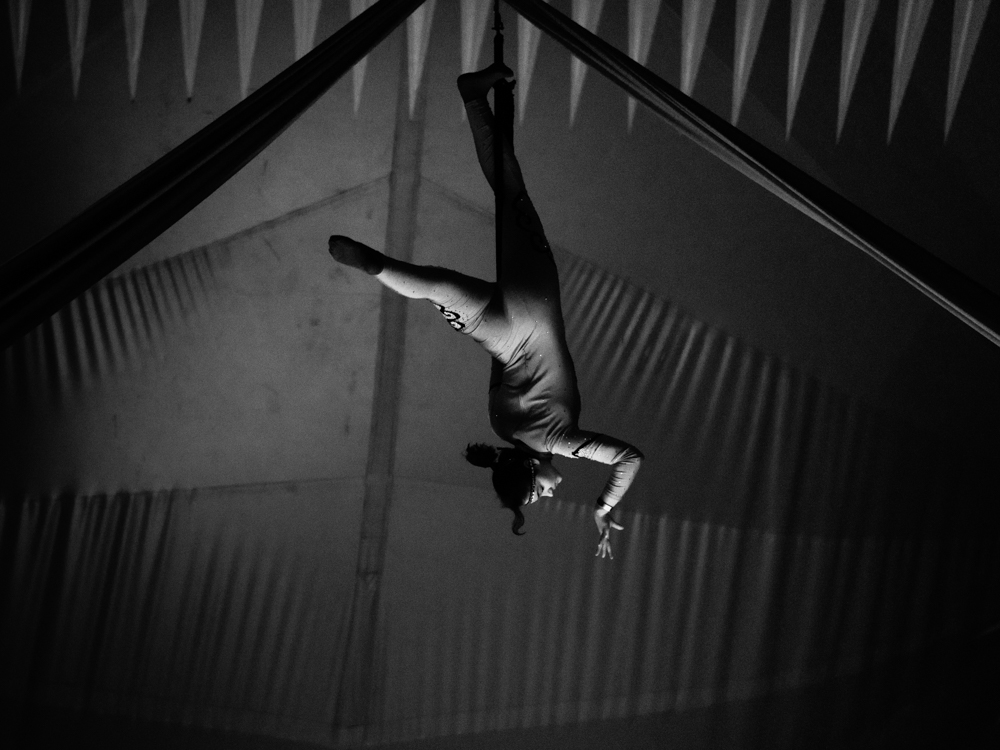
©Sigrid Debusschere, Circus girl performing, Every corner of the tent is being used during the show.
MH: The circus animals play a prominent role in your project yet again your images of the animals pull us away from the typical fierceness that circus animals normally convey. These are gentle creatures with quiet roles to play. How did this come about?
SD: Wild animals in circuses have been banned in Belgium since 2015. No tigers, lions, elephants, or other wild animals are allowed in the arenas. Exotic but domesticated species such as camels, buffaloes and llamas and classic companion animals such as dogs, horses, chickens, and geese can still be kept in circuses, provided the animal enclosures meet legal standards.
The animals are part of the circus family. They take very good care of them. There is mutual respect, emphasizing a harmonious partnership. By portraying animals in a gentle light, I tried to evoke empathy and encourage viewers to consider the well-being of these creatures. This approach aligns with the growing awareness of animal welfare issues.
I also had the opportunity to capture the animals during their downtime, showing them in moments of rest, interaction, or play. These shots reveal a different side to circus animals’ lives.
MH: What do you hope viewers take away from your photographs and the stories they tell?
SD: These experiences taught me that circus life is a multifaceted tapestry of relationships and aspirations. Through my photography, I aim to convey not just the spectacle but the humanity that thrives within the circus world, capturing moments that challenge preconceptions and offer a deeper connection to the remarkable individuals who call the circus their home.
This approach allowed me to create a more nuanced and authentic portrayal of circus life, capturing the spectrum of emotions that exist beyond the spotlight, while also inviting viewers to connect on a deeper level with the individuals who make the circus their world.

©Sigrid Debusschere, The camel in the spotlight, Circuses take good care of their animals. They are like their children, with feelings of their own.
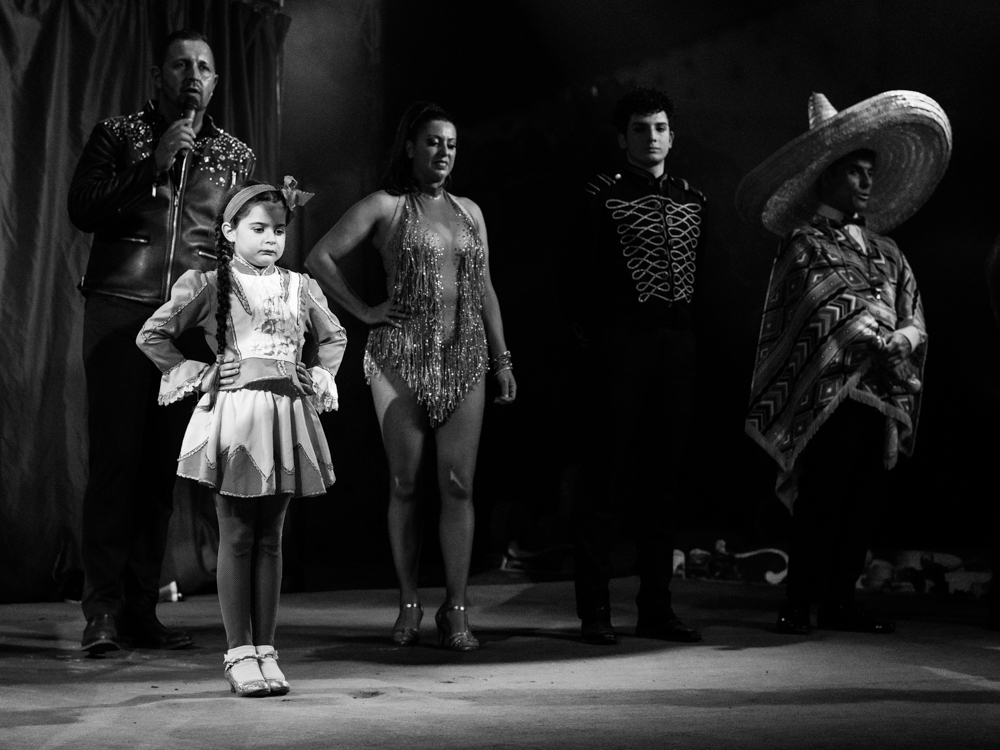
©Sigrid Debusschere, End of the show, The entire circus family comes on stage to thank their spectators.
MH: Are there any specific circus moments that left a lasting impression on you?
SD: The day the small circus family set up their tent and eagerly prepared for a show, only to find that nobody came to witness their performances. The mix of disappointment, and frustration settled among the performers, staff, and crew.
However, amidst the disappointment, it was also a moment of resilience and unity. The circus is a tight-knit community, and the performers and crew are like an extended family. In this difficult situation, they came together to provide support and encouragement to one another, reminding themselves of the passion that drives them.
Local neighbors came with their kids to buy popcorn and cotton candy, which accentuates the circus historic role in organizing community gatherings and the unique joy they bring to the kids.
For the circus family, this experience served as a reminder of the unpredictability of their chosen path. The circus life is characterized by highs and lows. The financial implications is a constant stress, as the absence of ticket sales meant a loss of income and impact their ability to sustain their nomadic lifestyle. Taking care of their animals also a daily concern and represents a big budget in their family life.
MH: What other projects or subjects are you interested in exploring in the future?
SD: Eager to engage in long-term documentary projects that delve into specific communities, subcultures, or aspects of society, gives me plenty of subjects to explore. Telling in-depth stories, meeting people and find out more about their lives is always interesting.I have plenty ideas in my head, some of which I try to work on, every time I’m in a different city.
As I am a big fan of photobooks, I like to make a series and design, print, and bind my own handmade zines. With an old camera belonging to my father, I started taking analogue photos and developing them in the darkroom. This is a good exercise in testing my patience.
Posts on Lenscratch may not be reproduced without the permission of the Lenscratch staff and the photographer.
Recommended
-
Martin Stranka: All My StrangersDecember 14th, 2025
-
Interview with Maja Daniels: Gertrud, Natural Phenomena, and Alternative TimelinesNovember 16th, 2025
-
MG Vander Elst: SilencesOctober 21st, 2025
-
Photography Educator: Josh BirnbaumOctober 10th, 2025
-
Aiko Wakao Austin: What we inheritOctober 9th, 2025


